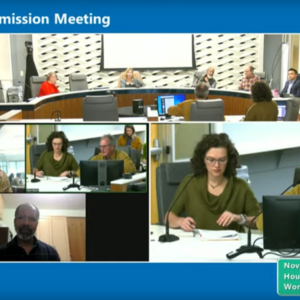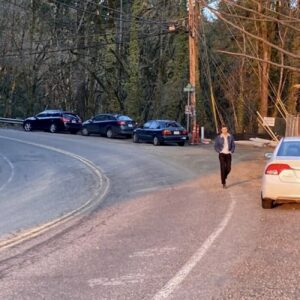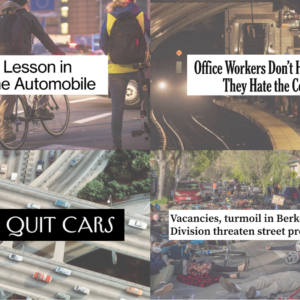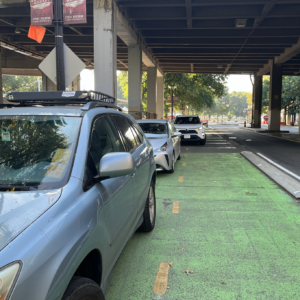When it comes to planning a city, trips matter. Estimates about the amount of trips generated by a transportation project or new development are what dictate not just what our redesigned streets will look like, but also how we pay for them.
One of the ways the City of Portland pays for infrastructure is by charging developers a fee based on the impact their new building will have on the transportation system. These fees — known as Transportation System Development Charges, or just TSDCs for short — are based on a model that estimates how many trips a new development will generate.
There’s just one small problem: The methodology is centered almost exclusively around cars. The Portland Bureau of Transportation wants to change that.
At City Council today commissioners unanimously passed an ordinance (PDF) allowing PBOT to use a methodology that uses “person trips” – meaning trips made not just by people in cars and trucks but also foot, by bike and in transit vehicles.
Brian Davis, a transportation analyst at Lancaster Engineering, said the methodology Portland currently uses is based on the Institute of Transportation Engineers (ITE) Trip Generation Manual which he calls, “very car-oriented.” “All our land-use and transportation planning is based on this manual which relies on data collected in suburbs in the 80s and 90s.” Therefore the data, Davis says, “Is massively overstating the number of car trips a development will result in.”
Advertisement
“If you’re just planning for cars than we’ll only have a system for cars.”
— Kelly Clifton, the Transportation Research and Education Center (TREC) at PSU
This matters because the car-oriented data tells engineers and planners that intersections have to be wider, parking lots have to be bigger, and so on. And if a city doesn’t do what the manual says, they can be open to lawsuits.
On the TSDC side of things, the ordinance comes as PBOT is updating how they set the fees and what types of projects they should fund. At Council today PBOT’s Christine Leon said the new methodology would set the city on a course to use a person-first trip generation methodology as the basis of their TSDC program. She brought in noted Portland State University researcher Kelly Clifton. Clifton told Mayor Charlie Hales and city commissioners that the idea is to, “Put people at the center of our planning universe.” “People make trips,” she said, “Not just cars.”
Clifton also pointed out that the existing methods based on cars and suburban land-uses, “Have contributed to the marginalization of other modes.” “If you’re just planning for cars,” she said, “Than we’ll only have a system for cars. We need to have our methods be commensurate with our goals.”
The new methodology is an exciting step that could have implications for Portland transportation planning well beyond fees we charge developers. The idea of person trips is closely related to the road capacity concept known as “level of service”. That methodology is very car-centric and has vast ramifications for infrastructure projects. If we begin to quantify road users as people doing a variety of things — not just driving a car — than we can start looking at a multi-modal level of service and begin planning for the city we want.
With passage of the ordinance PBOT can now further refine the tool. They will return to council with an update in mid-2017. Learn more about the TSDC update on the city’s website and stay tuned for opportunities to weigh in.
— Jonathan Maus, (503) 706-8804 – jonathan@bikeportland.org
BikePortland is supported by the community (that means you!). Please become a subscriber or make a donation today.






We should still charge developments based on the number of car trips or miles they generate, in order to have the right incentives for developers and occupants.
We will do that. This new methodology would put people first — whether they are on bikes, foot, bus, light rail… Or in a car. It includes all users.
So what does that mean for actual fees collected and how they are spent? Does this mean that if a building is likely to generate more bus trips, that the bus infrastructure will need to be modernized? Or that buildings on bicycle-heavy streets will be required to build protected cycleways? Or does the money just go into a big pool for PBOT to determine how it gets spent?
Good questions… and I think that’s why PBOT is doing a complete update to the TSDC program. They want to hear from people like you about what type of projects should be funded. I don’t think they’ve set any open house or comment period dates yet… but here’s the official project website https://www.portlandoregon.gov/transportation/71823.
It sure would be exciting to allocate SDCs by desired mode share so that ped/bike crossings, bridges, trails, etc. have a dedicated chunk of funds to use. Similarly, the city could allocate funds to transit capital improvements such as bus only lanes and other measures that make transit travel faster and more reliable. I could also see some of the transit funds go toward concrete bus stop pads in the roadway, since bus stops tend to have the worst/most warped pavement in the road system.
Welcome new thinking in the developement planning realm.
The method for assessing fees is still under development and will be presented in 2017. However, the point made today is that the foundation for the method will be person trips. Thus all trips will be counted, not just cars. This gives us a better basis for understanding the impact of development and taking appropriate measures to plan for all modes. It also gives more flexibility to think about how to plan for the city we want, not just replicate current or past patterns. Stay tuned!
I get the desire to track, count, log, parameterize all trips, but I guess the part I’m still struggling with is the fact that some trips (bike, feet) don’t have any negative impacts on our city, whereas others (car, pickup, motorcycle) do. I don’t think what you are suggesting is to lump all of these together, but some of what I read above seems to skip over this.
You are right to point this out. The approach doesn’t aim to lump modes together. The current methods tend to start with cars only. We benefit by starting with people first, then thinking about the modes they take or will take if we improve/degrade conditions. And while bikes and pedestrians have fewer/no impacts, they still need infrastructure. This approach just gives us a better starting point.
Got it. The article could have been a bit clearer about that.
Thank you.
Will we plan and assess fees for the mode share we have, the mode share we expect in five years, or the mode share we want?
If I had my way, it would be the latter…We decide what we want a neighborhood or city to be, figure out the projects to get us there, calculate the appropriate proportion of costs of those projects that future growth should pay for based upon the relative amounts of trips expected. Lots of work needed to get us there, but a better way to plan. But this isn’t up to me…
Yay!
– “Proximity not mobility…” and then
– “Move people not vehicles…”
Sadly a lot of these projects will still rely on the ITE (9th) Trip Generation manual which is great for “predicting” suburban style car demand (predict as in: “build it and they will park!”) Sadly NACTO has not come up with an alternative urbane trip gen manual (or weighting factor for the ITE)…PSU can you get on this! 😉
We’re on it! ITE is adopting our methodology as recommended practice in the next edition (after we said we and other cities are going to make our data and methods open source). That said, we’re going to have to collect a lot new data to support the change in thinking. But we’re here and eager to help.
Counting person-trips rather than car trips sounds like a step forward to me. How can you have a humane city without focusing on the people?
Still confused. Is this giving developers a chance to say “we expect everyone at our new apartment building will bike since it has no car parking (except all that “free” on-street parking in the neighborhood), plus we’re calling it ‘The Peloton,’ so we shouldn’t have to pay much for transportation system development charges”?
You are right to be confused. This is just the first step and lots of work to do to figure out the details. But it is unlikely developer can just make claims like you suggest and get out of paying TSDC.
Also confused: “if a city doesn’t do what the manual says, they can be open to lawsuits.” Meaning, if the City doesn’t build massive car-oriented infrastructure for every new apartment building, someone can sue? Who would have standing to do that? Has this ever happened?
I think it would be baseless to sue if a city replaces a generic national database with a database of locally-sourced data on trip generation by various modes. Generally, the latter is better and I expect a court would uphold the locally-generated methodology. The ITE is a court-tested sound methodology in the absence of any other however.
I support evaluating projects based on person-trips, as it reflects a much more accurate view of developments in any setting – urban, suburban, or rural. I must state my opinion that Mr. Davis’ comments regarding the ITE Trip Generation Manual reflect a very rudimentary understanding of the underlying data supporting the manual. With a little reading, research, and quantitative analysis, many transportation professionals have been successfully applying the ITE Trip Generation Manual in person-trip based analyses for years. At least, that is my experience in California. It is unfortunate that the ITE Trip Generation Manual continues to be belittled by transportation professionals who seem to only skim the pages, with what appears to be a lack of understanding of the methodology and data supporting the findings. Like most things these days, broad generalizations hurt the entire profession by minimizing facts and data. I would be happy to continue this discussion offline with any professional.
All this various “modes” stuff is crap. Getting rid of LOS means the anti-car folks will be able to rationalize deliberately making traffic worse by taking away traffic lanes and street parking to make bike lanes for a “mode” used by a small minority of travelers.